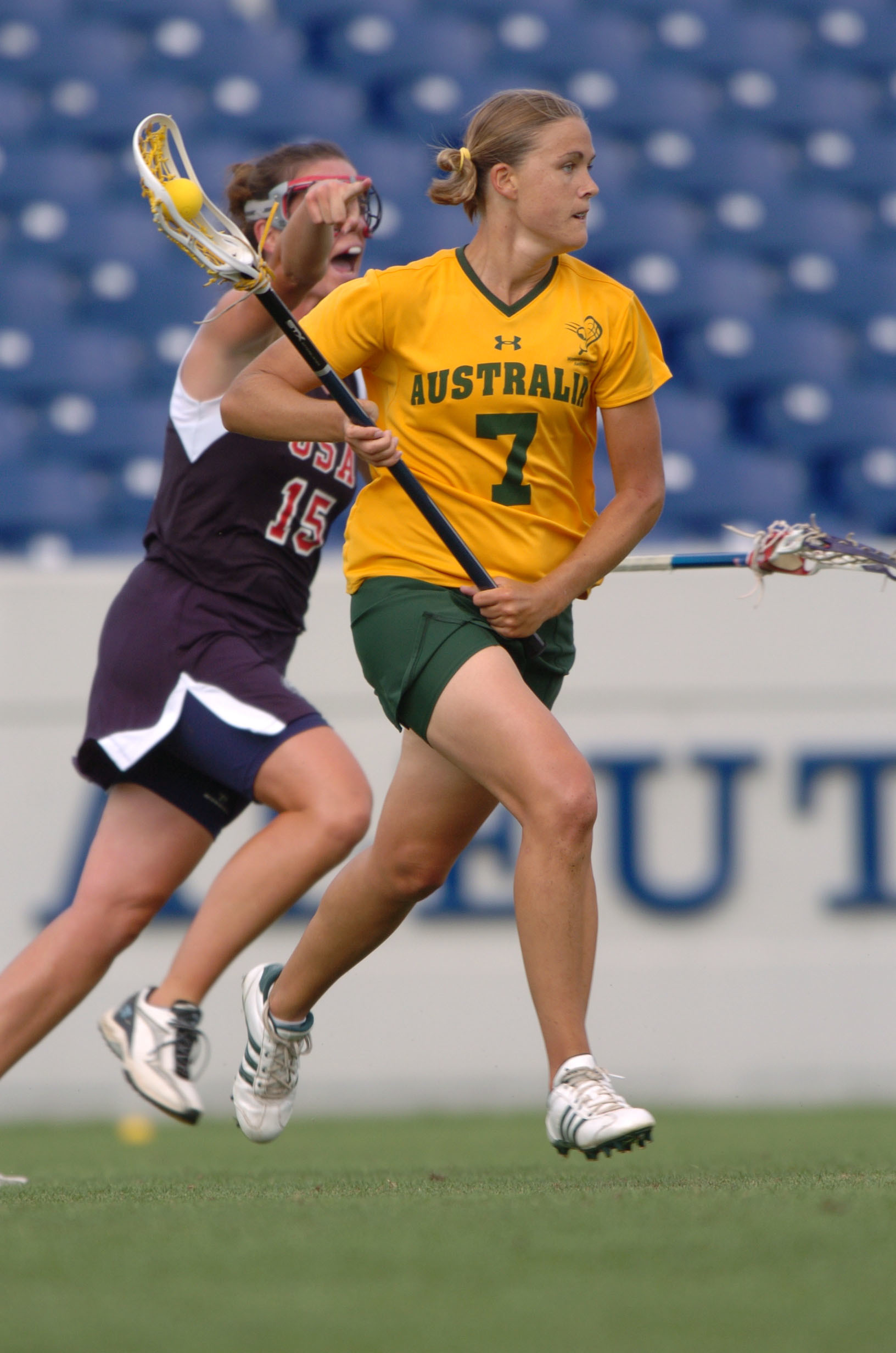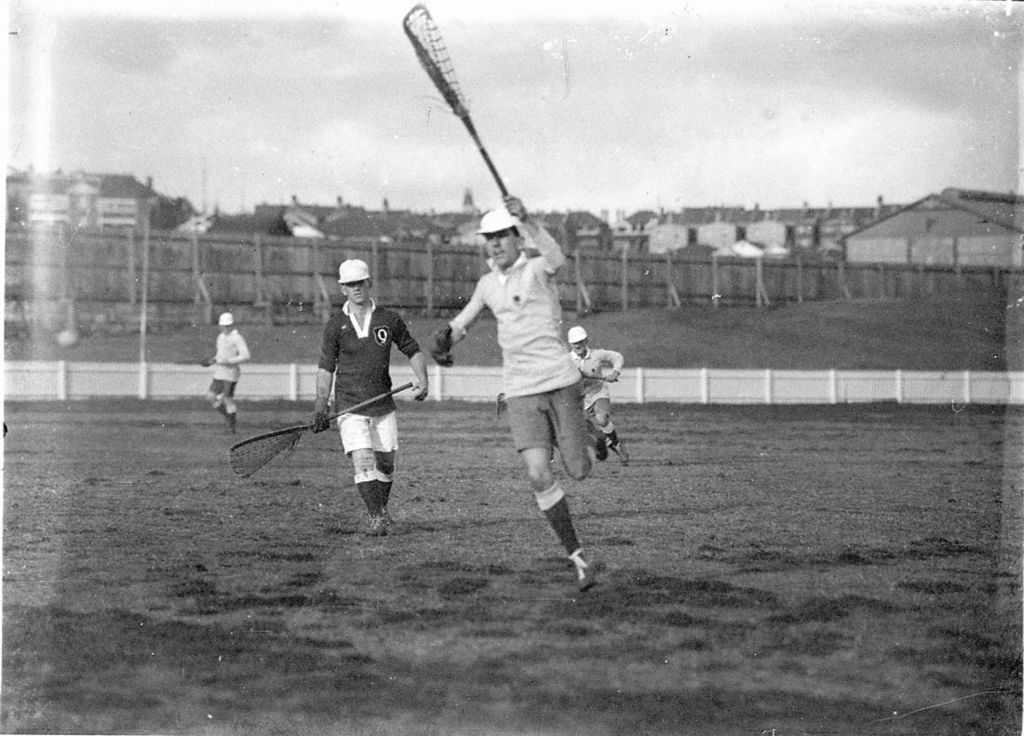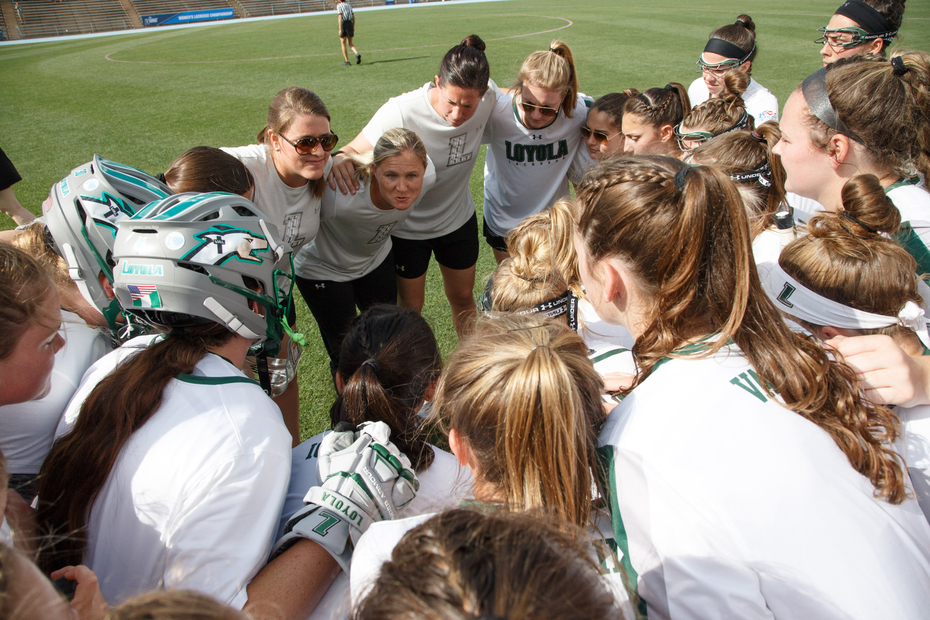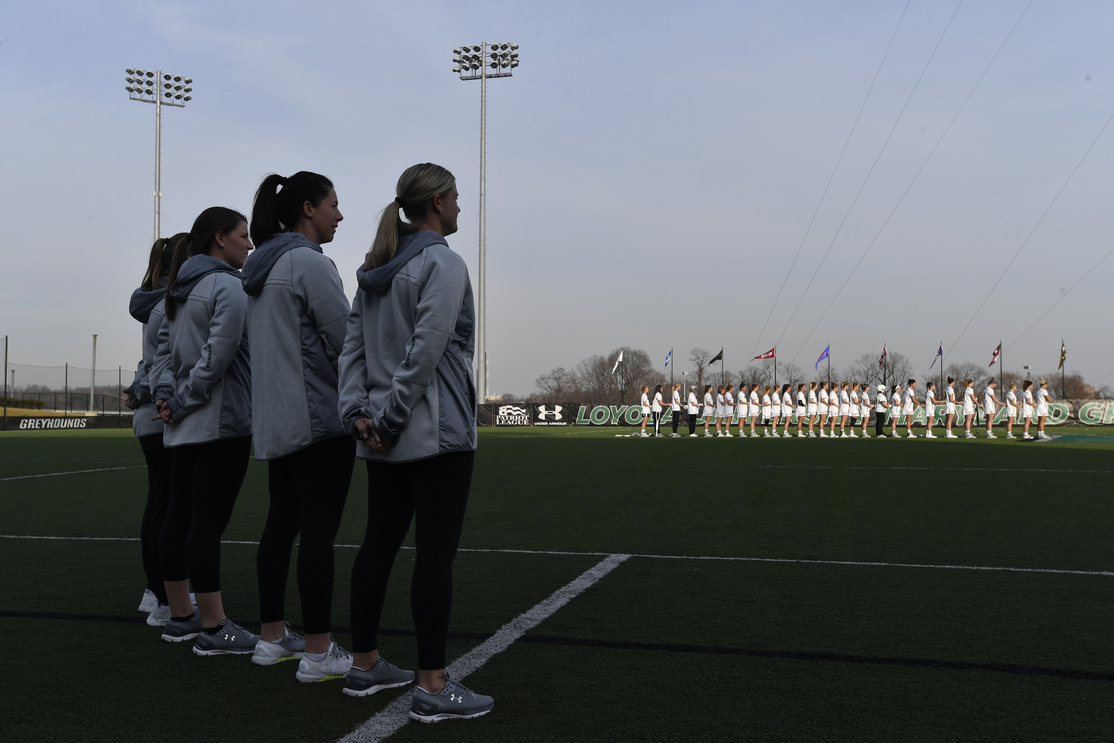Lacrosse is not a pursuit many Australians would associate with high level sporting excellence for its native daughters and sons.
The sport – thought to have its roots in an indigenous American game from as far back as the 1100s – sees players use long-handled netted sticks to attempt to score goals at either end of a rectangular pitch.
Videos by VICE
Called the ‘fastest sport on two legs,’ it’s physical, tactical, mostly played in the United States and Canada – and features a South Australian as one of the code’s best ever.
Adelaide’s Jen Adams is considered by many as the finest female player to ever pick up a lacrosse stick. A three-time national player of the year, Adams played for the University of Maryland between 1998 and 2001 setting college records for career points (445), goals (267) and assists (178) that still stand today.
Not only that, Adams is the only woman to have been drafted into the all-male National Lacrosse League, and was the first Aussie to be inducted into the US National Lacrosse Hall of Fame, in 2012.

Jen Adams was a long-time Australian lacrosse representative, winning the women’s World Cup with the side in 2005. Photo credit: Larry French.
Quite simply, she’s an absolute legend in the sport. Yet because of lacrosse’s non-mainstream nature in Australia, Adams has very rarely received, in her home country, the recognition and profile her athletic achievements should have delivered her.
Surprisingly, lacrosse has a long history Down Under. According to Lacrosse Victoria, the sport was founded in Australia by Canadian Lambton L Mount in 1876.
Mount, who emigrated to Australia with his family in 1850s seeking fortune on the Victorian goldfields, watched a Aussie Rules final between Carlton and Melbourne in 1875 and decided that lacrosse was a superior spot.
The following year he organized the first game and by 1879, there were four clubs around Melbourne with 120 players. A Victorian women’s amateur association was later formed in 1936. The national women’s team won the world title in 1986 and 2005, which Adams was a part of. The sport remains relatively strong in Victoria, as well as South and Western Australia, but remains pretty low on the totem pole in terms of national profile.
After reading about her in an old Sports Illustrated story a couple of weeks ago, I decided to track down Adams and see what she’s up to today.
Now 37, the South Australian is still a massive figure in the sport, both in Australia and the United States. Adams has been the head coach of Maryland’s Loyola University women’s team since 2008. The team is a regular challenger for silverware.
Adams is also a big force in attempting to bring lacrosse back into the Olympic fold. Most recently a sport at the 1948 Olympics, there is a movement to bring the code into the mix for the 2024 Games. Adams is serving as an athlete’s representative on an IOC committee looking at its re-inclusion.
I connected with Adams last week and had the following discussion about her life in lacrosse for VICE Sports AUNZ.

A Queensland vs New South Wales state lacrosse game at the Sydney Cricket Ground, circa 1930. Photo credit: Hood Collection/WikiCommons.
Gidday, Jen. For most Aussies growing up, lacrosse isn’t really a sport on their radar. How did you get into it?
“I got into lacrosse through Brighton Lacrosse Club, who were running school clinics on soft-toss lacrosse. That’s a modified kind of lacrosse. I was actually too young to participate at the time, but I was fortunate to have an older sister [Trish] who I followed around like a shadow.
“I was out watching her game one day and they needed an extra player to make up numbers on the field. They dragged me in. I picked up a stick for the first time and got hooked. So, that was my first taste of lacrosse; a school competition that the Brighton Lacross Club had set up.
“They didn’t actually have girls lacrosse at the time, but urged us and said ‘if you get a group of girls together and show up in the following year, you can put a team together.’ We grabbed some friends and some other girls from families involved in the club, and that’s how it all started.”
What was the standard or health of Australian lacrosse back when you started?
“A very high level of lacrosse was being played in South Australia. It’s very concentrated in Australia. There are three key states that play and are still very competitive; South Australia, Victoria and Western Australia.
“For us, with the concentrated level of lacrosse, we were lucky enough to pull over some athletes from other sports and get them involved, and passionate, at a young age.
“That was, I think, the reason we were successful back then and are still today. It is not sheer number of participants, but it’s the quality of participants that played. You’re constantly practicing and playing against other really great athletes and players, and that bodes really, really well.”

Australian Jen Adams (positioned centre, looking towards camera without glasses) firing up her Loyola women’s lacrosse team, pre-game. Photo credit: Peyton Williams/Loyola Athletics.
What is the health of sport, in Australia, today?
“Clubs systems based in those states were it is still so strong are steeped in tradition, so they continue to keep it sustaining and alive. It’s just hard when you don’t have that in those other states, to start it from. You don’t have the traditions, the club-bases systems or families that are pulling in other families.
“Lacrosse is a sport where we still struggle for participation. We’re non-mainstream, and lose a lot of these young athletes at a young age to sports that are a little more traditional [in Australia] like netball and softball in terms of girl’s sports. Lacrosse has really struggled in that way.
“But [in those stronger lacrosse regions], when families bring other families in, and get into that culture, lacrosse is a sport you tend to do, for life.”
From your perspective, what needs to happen to lacrosse to help it achieve the profile to attract more young athletes to it, both in Australia and internationally?
“I think a big thing needs to happen for that to happen. The participation in America obviously make them a powerhouse in terms of going to World Games. For the rest of us, we need to be recognized as an Olympic sport. There’s a huge push for that right now.
“I think if that gets through, we get recognized and start using the Olympic rings and get more exposure on that elite level, we can get into Institutes of Sport in the different states. That’s how it’s going to grow. If we don’t have that, we’re going to lose young girls who might get into soccer or something that does have a bigger platform for itself.
“The time is right, the time is now – and we’ve got all the right people making a push for it. The time is ripe.”
During your time at Maryland, you arguably became one of the sport’s first true women’s stars. How do you reflect on your career in college lacrosse now?
“Looking back now, I think I was naïve at the time to understand what I was a part of. We were just going about our business. We were firm believer at Maryland that success brings success, and I entered into a lineage of success.
“To just put on the Maryland jersey and be a part of that felt special – like you were part of making that history. I was just fortunate to be around such great people – coaches that pushed me out of my comfort zone and be the best version of myself I could be.
“I wouldn’t be where I am without the support of the people I played with. I’ve always shied away from individual awards, because I play a team sport. I was very lucky to be in the situation that I was.”
Adams’ induction video to the US National Lacrosse Hall of Fame in 2012. Source: US Lacrosse Official Channel/Youtube.
You’re now a coach of college lacrosse. How much has the sport changed since you were playing in the late 90s and early 2000s?
“I think the really cool thing for me, having played and looking back as a coach, is the athletes the sport draws now. We’re competing with these other sports [in the US] – really great athletes want to play the sport. It’s coined as the fastest game on two feet, and I think that’s attractive to a lot of young athletes as they come up.
“We’re seeing a better level of athletes; stronger, faster and more innovative. That’s changing it obviously. The rules themselves, since I played, have come a long way. I was in an era when it felt like a lot of change was being made, but now it feels like the sport is really trying to keep up with the athletes – which is good.
“They’ve introduced things like shot clocks and quick starts to make the game more fair and friendly, but also more exciting to play.”
It goes without saying, but there aren’t many people with an Australian accent participating at the elite level of lacrosse as you have. What has life been like carrying the flag for Australia in the sport?
“I’m an incredibly proud Aussie, and preach it everywhere I go. I was very fortunate to have the opportunities that I’ve got here in the States and certainly am not unaware of the fact I couldn’t be doing what I’m doing back home.
“On the same token, when I have an opportunity to represent my country or speak about it, it’s something I’m extremely proud of. In lacrosse, we’ve had enough [Australian] players come across and really make a difference in their respective colleges so when people think of an Aussie in the sport, they think of high level lacrosse.
“It’s created an Australian brand of lacrosse here in America that people respect. [That brand] is high tempo, but Australians also tend to be very innovative. They’re not afraid to give things ago, and that confidence comes through in the game.
“People always say we play a very freestyle version of lacrosse where we are very fluid in what we do, but at a very relentless pace or level. People sometimes say we look very casual and relaxed and free-flowing when we played, but everything is done competitively and intensely.”

A four-time national college champion with Maryland, Adams (closest to the camera) has been the head coach of the Loyola college women’s lacrosse team since 2008. Photo credit: Larry French/Loyola Athletics.
What’s the challenge of being a college lacrosse coach in the United States?
“I love the challenge and love the idea of being able to do something, and break it down. The reason I’m in coaching is I love teaching something and then watching players have it unfold in a game and see the smile on their faces when they get it right.
“A lot of people say good players don’t make good coaches, but I’ve found the opposite to be true. The good players who are passionate at what they are doing and willing to take their time to break it down do [make good coaches].”
You’ve been involved with lacrosse for more than twenty years now. What is it about the sport that has kept you hooked from playing right through to coaching?
“First and foremost, it’s a team sport. I love team sports and the idea of having to making all the pieces fit together and work in sync with each other. That and the comradey that comes out of team sport.
“But in terms of actually playing, I just don’t know another sport that involves so many facets of being an athlete. You’ve got the speed, the athleticism, you have to be agile, you have to be tenacious to get after the ball, you have to have great hand-eye co-ordination.
“It’s just a combination of all the sports and bits and pieces I loved growing up. I played lots of sports growing up, but to combine them all into one sport on one field was always an adrenaline rush for me.
“You have to get it all right, all of the time. You can’t just be fast; you’ve also got to see a ball, use your stick and be able to shot at over 80 miles per hour. There are just so many things that have to come together.”




